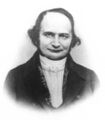Template:Selected anniversaries/February 18: Difference between revisions
No edit summary |
No edit summary |
||
| Line 38: | Line 38: | ||
||1844: Jacob Lüroth born ... mathematician who proved Lüroth's theorem and introduced Lüroth quartics. Pic. | ||1844: Jacob Lüroth born ... mathematician who proved Lüroth's theorem and introduced Lüroth quartics. Pic. | ||
||1849: Jérôme Eugène Coggia born ... astronomer and discoverer of asteroids and comets | ||1849: Jérôme Eugène Coggia born ... astronomer and discoverer of asteroids and comets. | ||
File:Carl Gustav Jacob Jacobi.jpg|link=Carl Gustav Jacob Jacobi (nonfiction)|1851: Mathematician and academic [[Carl Gustav Jacob Jacobi (nonfiction)|Carl Gustav Jacob Jacobi]] dies. He made fundamental contributions to elliptic functions, dynamics, differential equations, and number theory. | File:Carl Gustav Jacob Jacobi.jpg|link=Carl Gustav Jacob Jacobi (nonfiction)|1851: Mathematician and academic [[Carl Gustav Jacob Jacobi (nonfiction)|Carl Gustav Jacob Jacobi]] dies. He made fundamental contributions to elliptic functions, dynamics, differential equations, and number theory. | ||
| Line 67: | Line 67: | ||
||1943: World War II: The Nazis arrest the members of the White Rose movement. | ||1943: World War II: The Nazis arrest the members of the White Rose movement. | ||
||1944: Charles Davenport dies ... eugenicist and biologist. He was one of the leaders of the American eugenics movement. Pic. | |||
||1955: Operation Teapot: Teapot test shot "Wasp" is successfully detonated at the Nevada Test Site with a yield of 1.2 kilotons. Wasp is the first of fourteen shots in the Teapot series. | ||1955: Operation Teapot: Teapot test shot "Wasp" is successfully detonated at the Nevada Test Site with a yield of 1.2 kilotons. Wasp is the first of fourteen shots in the Teapot series. | ||
Revision as of 09:45, 19 February 2019
901: Physician, astronomer, and mathematician Thābit ibn Qurra dies. He made important discoveries in algebra, geometry, and astronomy; in astronomy, Thabit was one of the first reformers of the Ptolemaic system.
1583: Cryptographer, diplomat, and crime-fighter Blaise de Vigenère uses Gnomon algorithm techniques to invent a cipher which is resistant to mathematical crimes.
1809: Physicist and academic Antoine César Becquerel uses electricity to power new type of scrying engine.
1851: Mathematician and academic Carl Gustav Jacob Jacobi dies. He made fundamental contributions to elliptic functions, dynamics, differential equations, and number theory.
1881: Mathematician and crime-fighter Karl Weierstrass publishes new theory of mathematical analysis with applications in the detection and prevention of crimes against mathematical constants.
1899: Mathematician and academic Marius Sophus Lie dies. He largely created the theory of continuous symmetry and applied it to the study of geometry and differential equations.
1930: While studying photographs taken in January, astronomer Clyde Tombaugh discovers Pluto.
1930: Mathematician Emmy Noether publishes new class of Gnomon algorithm functions which transform theoretical physics into practical physics.
1967: American physicist and academic J. Robert Oppenheimer dies. His achievements in physics included the Born–Oppenheimer approximation for molecular wavefunctions, work on the theory of electrons and positrons, the Oppenheimer–Phillips process in nuclear fusion, and the first prediction of quantum tunneling. Oppenheimer has been called the "father of the atomic bomb" for his role in the Manhattan Project.
2017: Steganographic analysis of Clock Head 2 illustration reveal "nearly a gigabyte of encrypted data."
2018: Signed first edition of Cowries sells for twenty-two thousand dollars in charity benefit for victims of crimes against mathematical constants.










